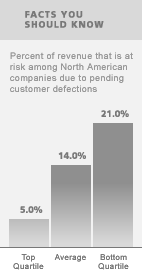
|

 |
 |


|
 |
 |
Most Companies Are Programmed to Lose Customers.
Despite the widespread adoption of customer satisfaction measurement programs, the typical North American company is at risk of losing 14% of its customers due to dissatisfaction.
We've conducted more than 100 studies, and we survey thousands of customers each year. The data tells us that most companies are inadvertently "designed" to aggravate their customers.
Even under the best scenario, there is no question that you will always lose customers. The key is to figure out how to keep your most valuable customers.
More facts you should know:
- 60-80% of defecting customers categorize themselves as 'satisfied' on surveys conducted immediately before their departure
- More than 50% of customers experience at least one problem with a company's products/services in a six month period
- Customers who don't experience problems are twice as loyal as those who do
- Only 34% of customers are completely satisfied with the resolution to their problems
- 68-73% of customers defect due to service/quality problems that, if known, would be relatively easy to fix
A False Sense of Security
The reason these facts come as a surprise to most senior executives is that conventional customer satisfaction metrics - used by most organizations - are poor predictors of customers' future behavior and consequences.
Conventional customer satisfaction research has fundamental shortcomings:
- It rarely produces actionable findings - it doesn't tell the company what to do, because the research:
- Asks 'how much do you love us' questions (the applause meter)
- Doesn't prioritize what to fix first
- Is insufficiently detailed (doesn't identify common customer issues that are actionable)
- It is rarely linked to direct financial impacts, such as:
- The cost of customer defections
- Where the company should invest to protect its revenues by improving its performance
- The return on investment from expenditures to protect revenues
In short, most customer satisfaction measurement fails to produce useful results because it focuses solely on the customer's attitude itself; and it fails to identify how that attitude was formed and how that experience will influence the customer's future behavior.
[top of page]
The Good News
An increase of just 5% in customer retention can account for a 20% increase in productivity and a 50-100% increase in profit margins.
The good news is that there is a solution. Rather than emphasizing customer satisfaction measurement and tracking, companies should implement programs that focus on measuring the prevalence and drivers of customer dissatisfaction. These programs can tell you:
- How much is customer dissatisfaction costing me right now?
- What could pending customer defections potentially cost us?
- What will it take to win back their loyalty?
- Where should I invest for the greatest payback?
- How do I reduce my lost business rate?
- How do I increase my "share of wallet" among individual customers?
- How do I differentiate my sales/service experience from that of my competitors?
More good news is that most of the factors influencing customer behavior can be directly influenced by the company itself. In other words, while your own customer contact channels may be driving customers away, you also have the power to turn that around.
All companies have customer retention challenges. So, the remedies are to:
- Determine what causes dissatisfaction among your customers and what each problem is costing you
- Apply sufficient managerial, technical and financial resources to remedy the problems based on payback; and
- Use these insights to achieve and sustain competitive advantage.
[top of page]
We Help You Keep Your Customers
For the past 10 years, professionals at The Verde Group have dedicated themselves to helping companies convert their most expensive customer dissatisfaction problems into loyalty and profits. We've done this through a unique approach called Revenue@RiskT, which calculates the revenue an organization has at risk due to potential customer defections - and tells you how to prioritize and fix the problems to improve retention. Revenue@Risk provides a predictive measure of customer behavior, details actionable insights, and links them to financial impact.
[top of page]
Click here to learn more about how our services can help you convert customer dissatisfaction into loyalty and profits.
 |
 |
|
|